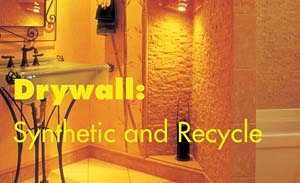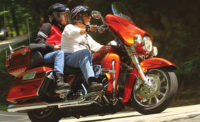

The collective ensemble of workers for the Azia Project (pronounced “Asia”)—everyone from the developers, general contractors and subcontractors—got to exercise their respective trades with new and state-of-the-art materials keeping in mind the sole focus of “green.”
This change of course for Omar Bradley, vice president for Sea Breeze Drywall, was by using drywall made from synthetic gypsum. The Azia Project is a model home built in Sea Breeze’s local Kill Devil Hills neighboring town of Corolla, both in North Carolina. This home, the brainchild of developers the Ambrosia Group, also located in Corolla, is basically constructed of all last year’s introduced products at the International Home Builders’ Show 2002. The general contractors had gone to Atlanta with the checkbook and plastic, and walked the stretch of the Georgia Congress Center (one of the world’s largest) on a spree that would be viewed by most contractors as excessive. Ceramic tile from Dale in the foyer, kitchen, baths and pool illustrate the home’s Oriental motif; furnace and plumbing supplies that meet LEED standards were purchased; a tankless water system and more.
“The concept behind Azia is a showcase of new and improved materials in the market today,” says Jay Wickens, of Ambrosia Group. “It’s a 3,200-square-foot home, with six bedrooms and six bathrooms.”

Shoppers’ delight
Among some of the products used relevant to the wall and ceiling industry, a new type of exterior cladding was chosen, called Novabrik. The product is a mortarless brick siding that can be affixed to wood and steel studs, and insulating concrete form systems. Mainly for residential projects, both new construction and remodeling, the benefit of this product is the installation is not dependent on weather, which in this case in North Carolina (near the Virginia border) still feel the impact of winter.For interior wall systems, another time-reducing asset to the Azia Project was the use of Lafarge North America’s synthetic gypsum drywall. In a time where resources and material have been cross-examined by associations, manufacturers and as of late, the green market, environmental concerns have aligned themselves with cost, labor and time. Synthetic gypsum produces fewer toxins and other pollutants in the air when manufactured, plus the board uses 100-percent recycled paper that sandwiches the drywall. The encouragement of this variation of board not only complements the green-thinking population of the 21st century, but also provides a cost-cutting solution for drywall producers.
“The guys were raving about the drywall used on this project, generally because the cut was clean and snapped easier than what they had worked on before,” says Bradley. “I was just watching the guys cut the board and it cut real crisp and straight, without pockets. Talk to the hangers—they’ll say it’s the best board they’ve ever hung.”

Prog rock
Boasting somewhere in the league of 600 homes per year, juggling work from a pool of 36 to 40 general contractors, it was important to get-in/get-out. So when Ambrosia asked Sea Breeze what board they thought met their progressive building practices, a type of Lafarge drywall was recommended.“We’ve been doing synthetic gypsum now since 1980 in Europe and Asia,” says Doug Phelps, sales manager for Lafarge North America. “Ambrosia is very much on the cutting-edge of building materials, and when those builders asked Sea Breeze Drywall what they thought was the latest-and-greatest material out there, Lafarge was recommended.”
Approximately 300 sheets of synthetic regular 1/2-inch drywall were used for the project. Sea Breeze also got to use diagonal corner beads, which they claim “had a good, new look to the walls.” Masked beneath the current knockdown texture the walls currently have, adhering to the Gypsum Association’s Level 5 was achieved under a tight deadline.
Dig deeper behind the finish, blown-in cellulose foam and regular insulation batts were used for maximum R-Value, as well as for soundproofing. Through and through, the concept behind this home was to offer absolutely the best that’s available on the market.
“There’s really nothing in this house that’s cheap,” says Wickens. “Altogether, we think it was $800,000 in materials.”
As the Azia Project conveys, products and ideas were utilized to offer homeowners an inexpensive future in utility payments, and contractors another way of marketing their trades. As this years IBS and CISCA shows have currently wrapped, but with a full year ahead of industry trade shows, equipment, tools, software, et al, change will be the norm.




